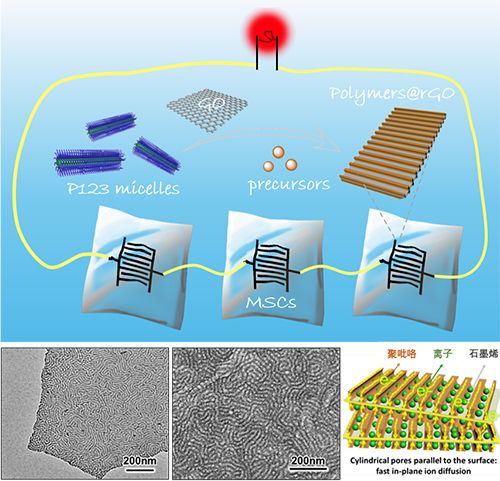A research group led by Prof. WU Zhongshuai from the Dalian Institute of Chemical Physics (DICP) of the Chinese Academy of Sciences, in collaboration with MAI Yiyong from Shanghai Jiao Tong University, developed 2D polymers with in-plane cylindrical mesopores on graphene nanosheets for micro-supercapacitors. The study was published in Angew. Chem. Int. Ed..
Two-dimensional (2D) nanomaterials, such as graphene, exhibit unique properties absent in their bulk materials. However, these 2D nanosheets easily tend to stack or aggregate together, leading to the limited accessibility of active sites and thus unsatisfied performance in energy-related applications, e.g., micro-supercapacitors (MSCs).
The growth of electrochemically active moieties on 2D nanosheets to produce 2D sandwich-like heterostructures was proven to be a promising strategy for the prevention of the stacking and thus the improvement of their capacitive performance in MSCs. On the other hand, mesoporous structure in electrode materials can largely increase specific surface area, reserve the electrolyte and facilitate the ionic diffusion pathways.
Thereby, patterning well-defined mesoporous electrochemically active materials on free-standing nanosheets, such as graphene, will produce novel 2D sandwich-structured hybrid nanomaterials for high-performance MSCs. Nevertheless, this remains a great challenge lacking of suitable templates and innovative techniques.

Schematic of the fabrication of 2D mesoporous polymer/graphene with in-plane cylindrical pores for MSCs; Morphological characterizations of mesoporous polypyrrole/graphene nanosheets; Schematic diagram of the roles of cylindrical mesopores parallel to graphene surface in the high performance of planar MSCs. (Image by QIN Jieqiong and HOU Dan)
To address the above issue, the scientists synthesized polypyrrole, polyaniline and polydopamine with in-plane cylindrical mesopores on graphene nanosheets by the interface self-assembly strategy.
The resultant 2D sandwich-structured nanohybrids were employed as the interdigital microelectrodes for the assembly of planar MSCs, which delivered outstanding volumetric capacitance and energy density. Moreover, the MSCs displayed remarkable flexibility and superior integration for boosting output voltage and capacitance.
The interfacial self-assembly protocol opens novel opportunities for patterning 2D porous nanosheets for planar energy storage devices.
The above work was supported by China's National Natural Science Foundation, and China's National Key R&D Program, etc. (Text by QIN Jieqiong)